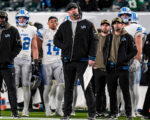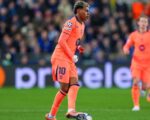DETROIT — «GRATITUDE» was embroidered in bold Honolulu blue and white letters on Aidan Hutchinson’s black hat as he put pen to paper on a life-changing contract extension Oct. 29.
The Detroit Lions’ star edge rusher expressed appreciation while surrounded by members of his inner circle, including his parents, Chris and Melissa Hutchinson, sisters Mia and Aria and the Hutchinson grandparents.
Inside the Meijer Performance Center, Hutchinson had just agreed to a four-year deal worth $180 million — including $141 million in total guarantees, tops for all non-quarterbacks. The reward for an elite player at a premium position was secure, and deserved.
Inside the Aidan Hutchinson extension
• No. 1 pick Cam Ward continues to progress
• Malcolm Jenkins talks Hurts scrutiny
• Are Falcons facing another QB reset?
• New Jets QB, same result
• Broncos’ McMillian comes up big
«You get that deep relief almost that the negotiations are over with,» Hutchinson told reporters the next day.
The family members in the audience understood that line all too well. Smiling for the cameras at a news conference is the easy part. Getting to the finish line on a deal this massive, which allowed Hutchinson to play this Thanksgiving matchup against the Green Bay Packers (1 p.m. ET, Fox) with his contractual future intact, took months of legwork. It also took a deep understanding of a ballooning pass-rush market that made Hutchinson’s contract value a moving target. Hutchinson’s recovery from a broken fibula and tibia in 2024 loomed large, too.
A few days before a deal was consummated, agent Mike McCartney had spoken with the Hutchinsons via phone, outlining the tough choices at hand: accept the Lions’ latest deal, which was loaded with guarantees but fell just short of Micah Parsons’ $47 million per-year contract with Green Bay, or wait this out with the hope of driving the market above Parsons’ deal.
The latter welcomes contention, forcing the player into a familiar playbook of holdouts and trade requests to apply public pressure and maximize dollars.
But that wasn’t the style of Hutchinson’s camp, which sought to avoid drama or media leaks throughout the process.
«Even though there was frustration at times, it was never contentious,» McCartney said of the negotiation. «We continued working until both sides were happy.»
Nick Bosa at $34 million per year.
Then came the avalanche, a market explosion that surpassed expectations among many around the league. Nearly all of the league’s top pass rushers were up for an extension at the same time, aligning with NFL teams’ insatiable thirst for applying pressure on quarterbacks.
Las Vegas’ Maxx Crosby surpassed Bosa on March 6 with a three-year, $106.5 million deal, a market reset that lasted three days.
Cleveland’s Myles Garrett had consulted the disgruntled player playbook to perfection, requesting a trade and openly commenting on contending teams that should court him. Right before free agency, on March 9, Garrett and the Browns reached a deal that brought the market to the $40 million per-year threshold.
Ten days later, Houston’s Danielle Hunter got a one-year deal worth $36.5 million. Pittsburgh’s T.J. Watt topped Garrett with a three-year, $123 million contract that was reached before training camp.
These veteran players were scoring these numbers despite being several years older than Parsons, 26, setting the stage for the then-Dallas edge rusher. Parsons’ negotiations went sideways with Dallas, with the player requesting a trade that Dallas eventually welcomed.
Takeaways, questions from each game »
• Graziano overreacts to Week 12 »
• Barnwell on three wild comebacks »
• Highlights » | Scoreboard » | More »
A source with direct knowledge of the situation added that Parsons’ deal gave Detroit pause, not necessarily deterring efforts on a Hutchinson deal but causing both sides to reset. One discussion that’s tried-and-true in player and team negotiations: How to interpret the Parsons contract comparison.
Though Parsons’ new money averaged around $47 million per year, the number was closer to $41 million per year when factoring in the fifth-year option from his rookie deal, which was built into the new contract. Teams often cling to the latter number to temper expectations, and multiple league sources believe that was a factor here.
Hutchinson trusted his parents to voice his desires and McCartney throughout the process, as his top priority was focusing on his journey back to the field after the broken leg that ended his 2024 season. His only request was to be informed once talks intensified.
But Hutchinson intensified them with his play, producing six sacks through the first six games. He was on a heater, just like at the start of last season (7.5 sacks through the first five games before the injury). The injury was an afterthought, and the contract was not.
«The way he was playing led [the Lions] to say, ‘Hey, this guy is playing at an All-Pro level, we have to get this done,'» a player source said.
Jared Goff, Hutchinson, Amon-Ra St. Brown, Penei Sewell, Alim McNeill, Kerby Joseph, Jameson Williams and Taylor Decker total nearly $1 billion in potential earnings.
General manager Brad Holmes and coach Dan Campbell have expressed a clear philosophy publicly: When they stack their star players against, say, free agency or trade additions, they typically like their guys better. Campbell says he prioritizes players the team has drafted and developed over three to four years against unknown players because they are more predictable.
This presents challenges to the Lions’ future salary cap outlook. The Lions have committed $243 million in 2028, the second most in the league. That was a factor in the Hutchinson negotiation. Hutchinson’s cash payout is $30 million in both 2027 and 2028 — two years when the Lions are heavy on commitments — versus $50 million and $45 million over the following two years. That’s why Hutchinson getting the early trigger on the 2029 guarantee was important for the player.
Both sides were willing to make concessions on a complicated deal because, as Campbell says of his star edge rusher, «He’s just us.»
That mutual respect makes $200 million conversations more palatable.
«It’s like with the guys that we have on this team, you want to be a part of it,» Hutchinson told ESPN. «We’re in this window of time right now where we have a lot of young players who are going to be here for a long time, and as long as we keep our core guys, the sky’s the limit every year.»
















